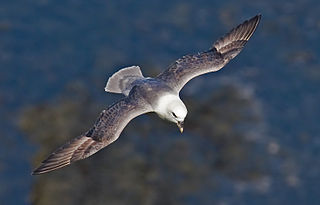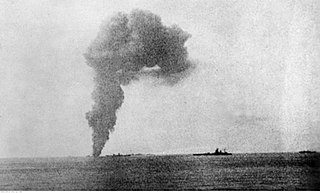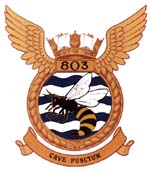
The fulmars are tubenosed seabirds of the family Procellariidae. The family consists of two extant species and two extinct fossil species from the Miocene.

The northern fulmar, fulmar, or Arctic fulmar is a highly abundant sea bird found primarily in subarctic regions of the North Atlantic and North Pacific oceans. There has been one confirmed sighting in the Southern Hemisphere, with a single bird seen south of New Zealand. Fulmars come in one of two color morphs: a light one, with white head and body and gray wings and tail, and a dark one which is uniformly gray. Though similar in appearance to gulls, fulmars are in fact members of the family Procellariidae, which include petrels and shearwaters.

The Fairey Fulmar was a British carrier-borne reconnaissance aircraft/fighter aircraft developed and manufactured by aircraft company Fairey Aviation. It was named after the northern fulmar, a seabird native to the British Isles. The Fulmar served with the Royal Navy's Fleet Air Arm (FAA) during the Second World War.

Operation Excess was a series of British supply convoys to Malta, Alexandria and Greece in January 1941. The operation encountered the first presence of Luftwaffe anti-shipping aircraft in the Mediterranean Sea. All the convoyed freighters reached their destinations. The destroyer Gallant was disabled by Italian mines and Axis bombers severely damaged the cruiser Southampton and the aircraft carrier Illustrious.

Empire Battleaxe was a British ship of the Second World War and as HMS Donovan in service with the Royal Navy just after the Second World War. Built as a Type C1-S-AY1 Landing Ship, Infantry named Cape Berkeley she then saw merchant service as Empire Battleaxe before being commissioned into the Royal Navy as HMS Empire Battleaxe and then Donovan. After she was decommissioned she returned to merchant service as Empire Battleaxe and was returned to the USA where she was renamed Cape Berkeley once again. A proposed sale in 1948 to China and renaming to Hai C fell through and she was scrapped in 1966.

Operation Substance was a British naval operation in July 1941 during the Second World War to escort convoy GM 1, the first of the series from Gibraltar to Malta. The convoy defended by Force H was attacked by Italian submarines, aircraft, and Motoscafo armato silurante.
USS Fulmar (AMS-47/YMS-193) was a YMS-1-class minesweeper of the YMS-135 subclass acquired by the U.S. Navy for use in World War II. Her task was to clear minefields in coastal waterways.
USS Fulmar (AMc-46) was an Accentor-class coastal minesweeper acquired by the U.S. Navy for the dangerous task of removing mines from minefields laid in the water to prevent ships from passing.

803 Naval Air Squadron was a Royal Navy Fleet Air Arm squadron.

USS Wachusetts (SP-548) was an armed motorboat that served in the United States Navy as a patrol vessel from 1917 to 1919. She was renamed SP-548 during her period of service. In 1919 she was transferred to the United States Bureau of Fisheries and renamed USFS Fulmar, and operated as a fisheries science research vessel on the Great Lakes until 1933 or 1934, when she was transferred to the Ohio Division of Conservation.
SS Empire Abbey was a refrigerated cargo ship built in 1943 and in service until 1966. She was also known as SS Teviot, SS Ardilles and SS Tung An.

Short Brothers Limited was a British shipbuilding company formed in 1850 and based at Pallion, Sunderland since 1869. The company closed in 1964 when it failed to invest to build bigger ships.

ST Sea Alarm was a 263-ton tug which was built as Empire Ash in 1941 for the Ministry of War Transport (MoWT). She was sold in 1947 and renamed Flying Fulmar. She was sold in 1956 and renamed Sea Alarm. On retirement in 1973 she became an exhibit at the Welsh Industrial and Maritime Museum in Cardiff, but was controversially scrapped in 1998 after the forced closure of the museum.
USS West Gambo (ID-3220) was a steel-hulled, single-screw cargo ship that served in the United States Navy from 1918 to 1919. She later saw commercial service as SS West Gambo and SS Empire Hartebeeste, and under the latter name was sunk during World War II.

Western Maid was a 5,760 GRT cargo ship that was built in 1918 by the Northwest Steel Company, Portland, Oregon, USA. She was built for the United States Shipping Board (USSB), but was commissioned into the United States Navy on completion as USS Western Maid, with the pennant number ID-3703. In 1919 she was decommissioned and returned to the USSB. In 1937 she was passed to the United States Maritime Commission. In 1940 she was transferred to the British Ministry of Shipping and renamed Empire Cormorant, passing to the Ministry of War Transport (MoWT) in 1941. In 1945 she was scuttled in the North Atlantic with a cargo of obsolete war matériel.
SS Empire Tower was a British 4,378 GRT cargo ship built in 1935 and sunk by enemy action in 1943.
The Fulmar was a cargo vessel that sank in the Atlantic Ocean off Kilkee, County Clare, Ireland, on the night of 30 January 1886. At the time of the disaster the ship was transporting coal from Troon in Ayrshire, Scotland to Limerick city in Ireland. Occurring 50 years to the day of the sinking of the Intrinsic, the ship is one of four that have perished with loss of life off the coast of the small town of Kilkee, the others being the Edmond, and the Inishtrahull.

Hawaiian Shipper was a 7,775 GRT Modified Type C3 cargo ship which was built in 1941 by Federal Shipbuilding and Drydock Company, Kearny, New Jersey for the United States War Shipping Administration. She was transferred to the Ministry of War Transport (MoWT) and renamed Empire Fulmar. She was transferred to the United States Maritime Commission (USMC) in 1942 and renamed Hawaiian Shipper. Converted in 1943 to a troopship for the United States Navy. To the USMC in 1946 and renamed America Transport. Sold in 1958 to the States Steamship Company and renamed Washington. Renamed Michigan and sold to the United States Maritime Administration in 1960. She was sold to the Waterman Steamship Corporation in 1969 and renamed Morning Light, she was scrapped in 1973 at Kaohsiung, Taiwan.

Empire Fulmar was a LST (3) which was built in 1945 by Davie Shipbuilding & Repairing Co Ltd as HMS LST 3524 for the Royal Navy. She was renamed HMS Trumpeter in 1947. She was tranferred to the Ministry of Transport in 1956 and renamed Empire Fulmar, serving in the Suez Crisis. She was later laid up in Singapore and was scrapped there in 1969.












